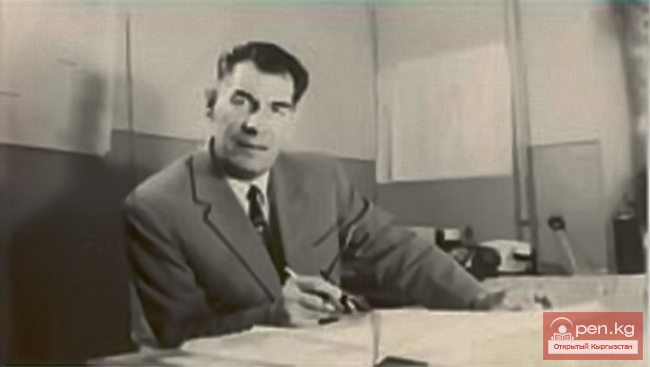VASILEVSKAYA - NAMED AFTER THE FIRST OF MAY - RAZZAKOV
The townspeople love this street. Located in the very center of the city, lined with trees, bordered by lawns and a green hedge, it is not quiet by city standards.
Until 1924, the street was called Vasilevskaya. According to the memories of local resident I. P. Deza, it was named after the penultimate city mayor, agronomist I. D. Vasilev. Before October, several mansions of the city nobility stood on it, and two pharmacies operated - a city one and a district one.
In the 1920s and 1930s, state institutions were concentrated here - the regional executive committee, then the regional executive committee, regional planning, regional health department, regional internal trade, postal and telegraph office, and others. In 1929, a telephone station for 300 numbers was set up in a one-story building.
In 1927, the first capital building - a hotel - was constructed (Architect A. P. Zenkov). In 1932, at the intersection with Alamedinskaya St. (since 1949 - Bastov), the building of the Communal Institute was commissioned (Architect Yu. B. Dubov), where the newly organized Higher Communist Agricultural School named after S. M. Kirov was established, preparing managerial staff for collective farms and state farms. The first graduating class consisted of 65 students and took place in December 1934. From 1939, a collective farm agricultural technical school operated in this building, later reorganized into a veterinary and crop production technical school. Subsequently, after the war, the Ministry of Agriculture was located there. By the way, the club in this building was for a long time the venue for many cultural events and even sports competitions.
On the corner of Krasnoarmeyskaya St., in a newly built three-story building, the Kyrgyz State Pedagogical Institute opened in 1934 - the first higher educational institution in the republic. It is interesting to note that only 71 students were admitted to the first year instead of 150. There were no students for the physics and mathematics faculty. The first graduating class of 46 students took place in 1936. Among the graduates were 13 Kyrgyz. Many of the first graduates became prominent workers in public education, the national economy, and science. Among them were Doctor of Historical Sciences, Professor, Academician of the Academy of Sciences of the Kyrgyz SSR B. D. Jamgerchinov, Corresponding Member of the Academy of Sciences of the Kyrgyz SSR K. Sh. Shatemirov, and honored teachers of the Kyrgyz SSR A. Joldosheva and U. Botbaeva, among others.
Here, in this building, for the first time in the history of Kyrgyzstan, from November 8 to 25, 1934, the 1st Republican Art Exhibition was held, featuring over 200 works of painting and graphics by 19 artists, including G. Aitieva, A. Ignatiev, L. Kasatkin, E. Maleina, V. Obraztsov, K. Cheprakov, S. Chuykov, and other masters of the brush. The opening of the exhibition was attended by the chairman of the Central Executive Committee of the Kyrgyz ASSR A. Orozbekov.
Currently, this building (and the buildings constructed later) houses the Kyrgyz Women's Pedagogical Institute named after V. V. Mayakovsky, organized in 1952 on the basis of the women's teacher training institute.
In the 1984-85 academic year, more than 2,750 students studied at 30 departments of the institute. Teaching is conducted by 301 instructors, including 6 professors, 4 doctors, 70 associate professors, and 95 candidates of sciences. In a one-story building of the former school for the deaf, on the corner of the current Lenin Avenue, opposite the post office, the Central City Library named after N. K. Krupskaya operated from 1940 to 1964. In 1940, a three-story dormitory for the agricultural technical school was commissioned at the corner of Frunze St. In the post-war period, from 1946, the Republican Party School operated there for a long time, preparing a large number of highly qualified personnel for party, Soviet, and economic leaders. In recent years, this building has housed the Regional Komsomol School, courses at the Central Committee of the Communist Party of Kyrgyzstan, a consulting office for the Higher Party School, and the editorial offices of the newspapers "Leninchil Zhas" and "Komsomolets of Kyrgyzstan".
Next to the post office, built in 1936, is the Ministry of Communications, and in a three-story building (the former Ministry of Internal Affairs) between Lenin Avenue and Pushkin St. is the State Committee for Cinematography; here also operates the editorial office of the children's magazine "Baichchekey," organized in 1977.
Between the building of the Supreme Council of the Kyrgyz SSR and the Museum of M. V. Frunze, in a one-story house since 1930, the central House of Defense of Osoaviakhim was located, with an auditorium and stage. The cinema "Udarnik" operated there, and performances were staged by the Young Spectator Theater. In the post-war period, the Russian Drama Theater named after N. K. Krupskaya operated in this building for some time, and from 1955 until its move to a new building in 1970, the Kyrgyz State Academic Drama Theater of the Order of the Red Banner of Labor staged performances there.
On the corner of Ivanitsyna St., in a one-story house, is the House of the Actor and the Theater Society of the Kyrgyz SSR, established in 1961. The society has over 800 members. Among them are the People's Artists of the USSR D. Kuyukova, V. Kydykeeva, A. Myrzabaev, K. Sartbaeva, laureates of the State Prize of the USSR A. Tokombaev, L. Moldokmatov, U. Sarbagyshev, R. Chokoeva, People's Artists of the Kyrgyz SSR A. Kobegenov, K. Chodronov, and many others. The first chairman of the society was the People's Artist of the USSR M. Ryskulov.
Above Toktogul St., in a two-story mansion, are the republican and city branches of the Society of Book Lovers. The Union of Composers of Kyrgyzstan.
On the corner of Frunze St., in house No. 100, lived the People's Artist of the Kyrgyz SSR, laureate of the State Prize named after Toktogul Satylganov, one of the oldest artists of the Kyrgyz State Academic Drama Theater of the Order of the Red Banner of Labor A. Botaliev (1906-1978). He created more than 80 stage images and was the first among Kyrgyz artists to play the role of V. I. Lenin in I. Popov's play "The Family".
By the decision of the city executive committee, a memorial plaque with a bas-relief of the artist was affixed to the house.
From Pushkin St. to Frunze St., on the site of demolished old houses, a green area - a park - stretches.
Losev D. S., Kochkunov A. S. What the Streets Tell
Streets of Bishkek














































